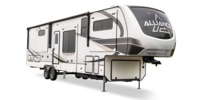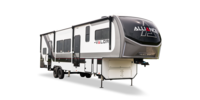RV solar panel systems are ideal for going off the grid in your RV and boondocking in nature. Solar panels on your RV give you a power generation source anywhere in the world, exponentially expanding the places you can dry-camp. But, hooking up solar power to your RV isn’t as simple as flipping-on a light switch, and the first thing you need to figure out is how many panels your RV needs.
Learn everything you need to know about the basics of RV solar panels. Find out how to determine the amount of solar power needed to charge your onboard batteries. And, see why it is so important to consult the professionals before biting-off more than you can chew on a DIY solar panel installation.
RV Solar Panels for Off-the-Grid Boondocking: How Many Panels to Get
A growing number of boondockers and off-grid RVers across the United States – and around the world – are excited to take their RV solar. If you want to get out into nature's wild and beautiful places, that only an RV can take you, an alternative power source is the only way to keep the lights on. And, recent advancements in solar technology have lowered its price and increased its efficiency, making it more popular for boondockers.
Solar power is a beautiful thing because it harnesses the sun's solar rays and converts the energy into usable electricity to power your RV appliances. The efficacy of solar power has always been clear, but until recently it was too expensive for average consumers. But, today, the solar industry is booming.
RV Solar Disclaimer: Don’t Go-it Alone Without Consulting the Experts
Even though solar is affordable, installing a solar system on your RV is a multifaceted undertaking and it can be a complicated project for most DIYers. Before you install anything on your RV, it is highly recommended that you consult an RV solar install specialist. They can help guide you through the process and direct you to the parts and equipment best suited for your RV or motorhome.
The purpose of RV solar panels is to convert solar energy into battery power. The more batteries your RV needs to power, the more panels you need. That being said, the first step to taking your RV solar is calculating the total Amp Hours (AH) capable of storage in your batteries.
Mounted RV Solar Panels vs Tilting Solar Panels
Solar panels are designed to face the sun at a 90-degree angle, which produces the optimal power conversion. When you mount solar panels to the roof of your RV, they cannot tilt to face the sun at a 90-degree angle, decreasing the overall wattage being delivered into your battery storage. In general, mounted solar panels receive up to 75% of the wattage delivery as advertised.
Some boondockers opt for ground panels, which offers the benefit of being able to place them at the optimal angle to the sunlight. Ground solar panels, however, negate the advantage of being able to passively power your batteries while you’re on the road, and they are higher maintenance in strong winds and bad weather. Mounted panels are more boondocker-friendly – as long as you clean off the panels regularly.
How to Determine Your RVs Battery Storage and Solar Panel Needs
A typical solar panel that you can mount on the roof of your RV delivers between 100 to 160 watts – as described by the manufacturer. A 100-watt solar panel generates about 30 AH of battery power charge when in the sun for up to 9 hours. And, a standard 12-volt lead-acid battery holds about 100 AH.
So, if you want to charge a 100 AH 12-volt battery on your RV, and each solar panel generates about 30 AH, you should have at least 3 solar panels. But, you also have to factor in that your RV solar panels will not always be receiving optimal sunlight exposure because they are mounted. As you can see, figuring out how many panels you need is not as simple as it sounds at first.
How Many Solar Panels Does Your RV Need?
In general, you need 300 watts of solar panel power to every 100 Amp Hours of battery storage capacity on your RV. So, if you have two 12-volts or any combination of batteries that equals between 200 to 250 AH, your solar panel output should be no less than 600 watts. Further expounding – for larger RVs with more batteries, like 5th Wheels and Class B motorhomes with between 400-600 AH battery capacity, you should have at least 1,200 watts of solar panel power on your RV.
Solar power is an excellent method of powering your RV for off-the-grid adventures. But, solar power system installations are technically complex, and the last thing you want to do is make a mistake that leaves you high-and-dry without power in the middle of the wilderness. So, if you’re ready to take your boondocking to new levels, talk to an RV specialist about the best method and equipment for your RV solar power.









